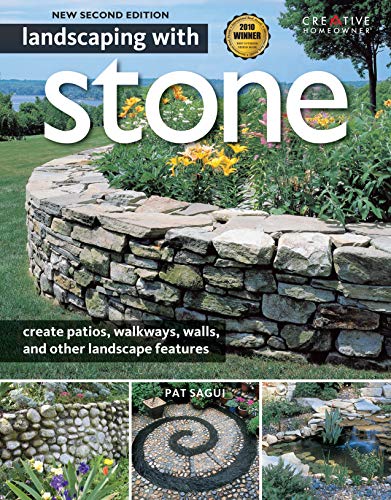You want to feel calm and connected to nature when you step outside. To achieve this, you must balance your garden’s hardscaping and softscaping. By using the right mix of these elements, you can make your outdoor space beautiful and improve your life.
When planning your garden, think about how hardscaping and softscaping work together. Hardscaping includes things like patios, walkways, and walls. Softscaping includes plants, trees, and flowers. By blending these, you can create a space that looks good and works well for you.
Key Takeaways
- Balance is key when combining hardscaping and softscaping elements in your garden.
- Hardscaping features provide structure and functionality while softscaping elements add natural beauty and texture.
- A well-designed outdoor space can enhance your quality of life and increase your property value.
- Consider the long-term costs and maintenance requirements of hardscaping and softscaping elements when making your design decisions.
- Landscaping design ideas should incorporate a mix of hardscaping and softscaping tips to create a unique and inviting outdoor space.
Understanding Hardscaping and softscaping
Creating an outdoor living space is all about mixing hardscaping and softscaping. Hardscaping uses materials like stone and metal for structure. Softscaping adds life to plants and trees.
For DIY projects, knowing hardscaping and softscaping is key. Patios and walkways work well with plants and lawns. This mix makes your space both beautiful and useful.
Defining Hardscaping in Landscaping
Hardscaping means using non-living materials in your design. Think stone, concrete, and metal. It saves water, lasts long, and is practical for outdoor areas.
Defining Softscaping in Landscaping
Softscaping includes living parts like flowers and trees. It brings color and life to your space. It’s cheaper than hardscaping and boosts nature in your garden.
Importance of Both Elements in a Garden
Both hardscaping and softscaping are vital for a great garden. They work together to make your outdoor area beautiful and useful. Knowing about them helps you create a stunning and functional space.
The Benefits of Combining Hardscaping and softscaping
Creating a beautiful outdoor space means using both hardscaping and softscaping. This mix boosts your garden’s look and function and even increases your home’s value. With the right garden maintenance advice, your outdoor area will be inviting and stunning.
A well-planned landscape can feel like an extension of your home. With backyard makeover suggestions, you can turn your outdoor space into a beautiful oasis. Hardscaping and softscaping together make your outdoor areas both beautiful and useful. Here are some key benefits:
Enhancing Aesthetic Appeal
Combining hardscaping and softscaping adds interest to your outdoor space. It creates a unique and welcoming atmosphere. The right mix of hard and soft elements lets you show off your style in a beautiful and functional area.
Improving Functionality and Usability
A well-designed landscape makes your outdoor space better for relaxing and having fun. With the right garden maintenance advice, you can make an area that’s both pretty and practical. It’s perfect for enjoying the outdoors.
Increasing Property Value
A well-designed landscape can also boost your home’s value. The right mix of hardscaping and softscaping makes your outdoor space more attractive. This can make your home more appealing to buyers. Here are some popular hardscaping materials and their uses:
- Natural stone: perfect for patios, walkways, and retaining walls
- Pavers & bricks: great for driveways, sidewalks, and outdoor kitchens
- Concrete: ideal for patios, walkways, and pool decks
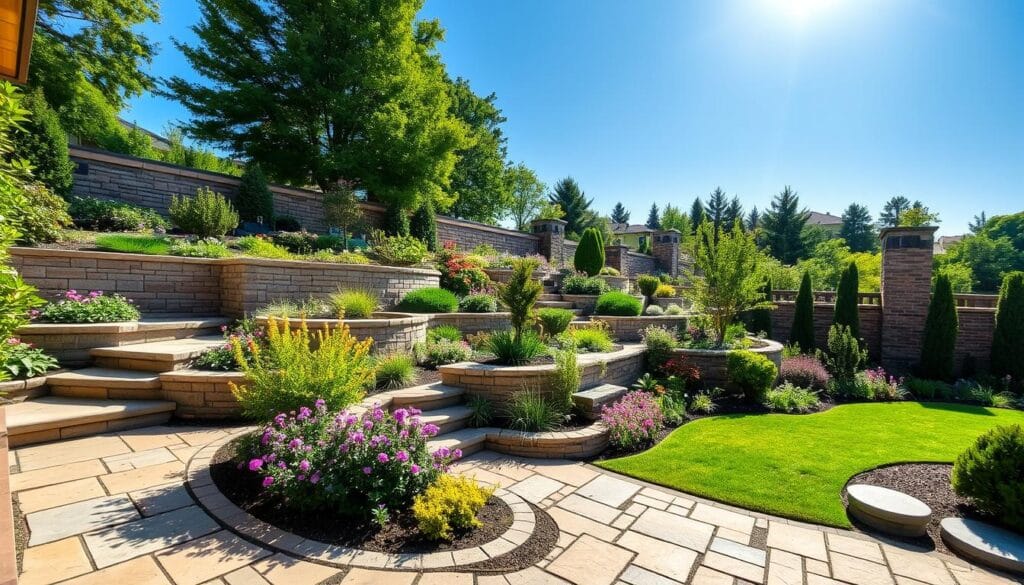
By using both hardscaping and softscaping, you can create a beautiful and useful outdoor space. This boosts your property value and makes it perfect for outdoor living. With the right backyard makeover suggestions and garden maintenance advice, you can turn your outdoor area into a stunning oasis.
| Hardscaping Material | Use | Benefits |
|---|---|---|
| Natural Stone | Patios, Walkways, Retaining Walls | Durable, Low Maintenance, Aesthetically Pleasing |
| Pavers & Bricks | Driveways, Sidewalks, Outdoor Kitchens | Easy to Install, Versatile, Cost-Effective |
| Concrete | Patios, Walkways, Pool Decks | Durable, Low Maintenance, Customizable |
Hardscaping Materials: A Complete Guide
Choosing the right materials for hardscaping is key to a beautiful outdoor space. The right plants can thrive with the right materials. Think about durability, upkeep, cost, and how it looks with your home and nature.
For lawn care tips, knowing hardscaping materials is important. You’ll find concrete, metals, wood, and synthetic materials. Each has its benefits, uses, and upkeep needs.
Common Hardscaping Materials and Their Uses
Concrete is strong and flexible, while metals are great for edging and structures. Wood is popular for decking, fences, and garden beds. Synthetic materials are durable and affordable for certain uses.
Choosing the Right Materials for Your Garden
Think about your climate, the space’s use, and your taste when picking materials. For example, in rainy areas, choose materials that drain well like gravel or permeable pavers. Always keep up with lawn care to keep your space looking good.
Maintenance Tips for Hardscaping Elements
Regular cleaning, checks, and fixes can make your hardscaping last longer. Knowing how to care for your materials is essential. This way, you can enjoy your outdoor space for many years, with beautiful plants adding to the landscape.
Softscaping Essentials for a Vibrant Garden
Softscaping is key in landscaping design, adding color, texture, and life to your outdoor space. It includes gardens, lawns, shrubs, and trees. These elements bring seasonal changes and visual interest.
Choosing the right plants for your climate is vital. Here are some popular picks:
- Tropical plants like hibiscus and Bird of Paradise for warm climates
- Hardy perennials like coneflowers and black-eyed Susans for temperate climates
- Cold-hardy plants like boxwood and holly for cool climates
To add color and texture, use plants with different foliage and flower colors. Seasonal planting strategies keep your garden vibrant all year. By mixing design ideas and inspiration, you’ll have a stunning garden.
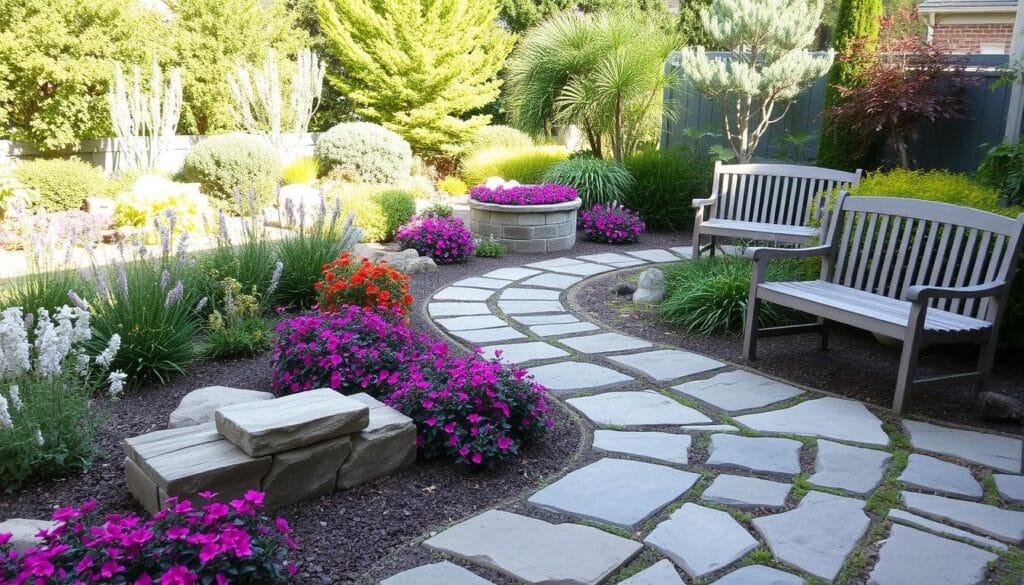
Follow these softscaping tips to create a lively garden. It will be a beautiful, functional space for you and your family to enjoy.
| Climate Zone | Popular Plants | Seasonal Planting Strategies |
|---|---|---|
| Tropical | Hibiscus, Bird of Paradise | Plant in spring and summer for vibrant colors |
| Temperate | Coneflowers, Black-eyed Susans | Plant in fall and spring for year-round interest |
| Cool | Boxwood, Holly | Plant in spring and summer for evergreen foliage |
Creating a Cohesive Design
DIY landscaping projects need a cohesive design for harmony and function. A good design balances hardscape and softscape elements. It should also reflect your style and the natural beauty around you.
Experts say 80% of softscape design planning involves site assessment, goal definition, and plant preference. Garden maintenance advice is key here. It helps in choosing the right plants, their placement, and care. This ensures your design meets your needs and beautifies your outdoor space.
- Assessing the site for the best placement of hardscape and softscape elements
- Defining your landscape design goals and preferences
- Choosing plants that fit your climate and soil type
- Creating a plan that mixes hardscape, like patios, with softscape, like plants and trees
By following these steps and using garden maintenance advice, you can make a beautiful and useful landscape. It will show your style and enhance your surroundings.
| Design Element | Importance |
|---|---|
| Assessing the site | 80% |
| Defining goals and preferences | 60% |
| Selecting suitable plants | 70% |
| Creating a design plan | 90% |
Essential Hardscaping Features to Consider
When designing your outdoor space, enhancing curb appeal with landscaping is key. Features like patios, decks, walkways, and retaining walls add structure and beauty. They make your yard more inviting and functional.
A well-designed hardscape can greatly improve your outdoor space. For example, patios and decks are great for relaxation and entertainment. Walkways and paths help connect different areas, making your yard more appealing.
Patio and Deck Designs
Patio and deck designs are vital for an outdoor living space inspiration. You can choose from materials like stone, concrete, brick, or wood. Each material brings its look and feel to your yard.
Walkways and Paths
Walkways and paths are key for moving around your yard. They can be made from various materials and patterns. This helps visitors see your yard’s best features and makes it feel more connected.
Retaining Walls
Retaining walls are not just for keeping soil in place. They also add beauty to your landscape. This makes your yard more inspiring for outdoor living space enjoyment.
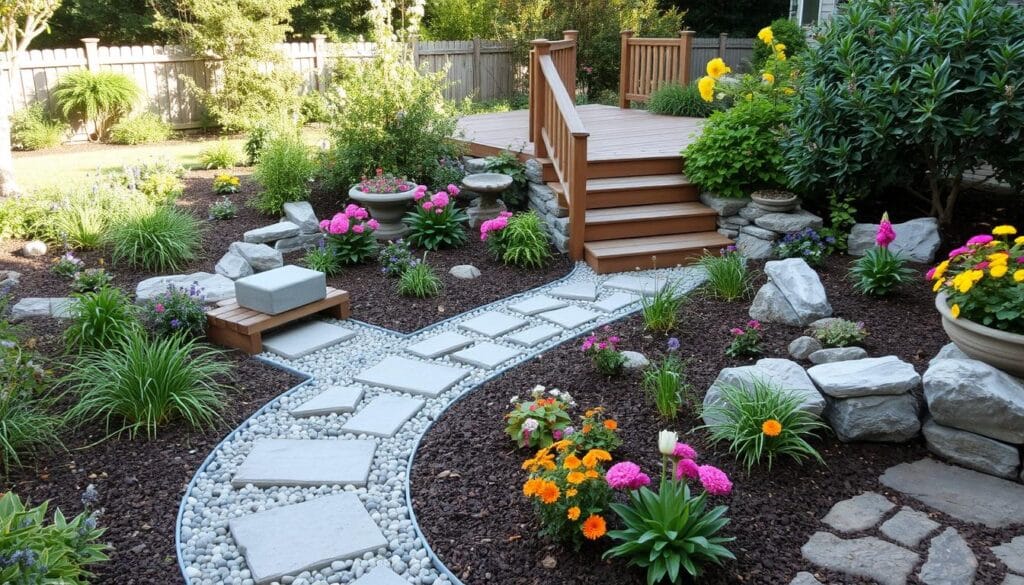
Adding these hardscaping features can make your outdoor space both beautiful and functional. It will also boost your home’s curb appeal and inspire you to enjoy your outdoor living space.
| Hardscaping Feature | Materials | Purpose |
|---|---|---|
| Patio | Stone, Concrete, Brick | Outdoor living and entertainment |
| Walkway | Stone, Brick, Concrete | Navigation and decoration |
| Retaining Wall | Stone, Concrete | Soil management and decoration |
Integrating Softscaping Features
Integrating softscaping features is key for a balanced garden. Plants, trees, and shrubs bring color, texture, and life. They work well with hardscaping like patios and walkways. Picking the right plants for your area is important.
Consider the climate, soil, and how much care you want. This helps you choose wisely.
Some important things to think about include:
- Flower beds and borders: They add color and texture. They can attract wildlife or bloom at different times.
- Shrubs and trees for structure: They give your garden shape. They offer shade, improve air, and create borders.
- Ground covers for texture: They fill gaps and reduce weeds and erosion.
Adding these softscaping features makes your outdoor space inviting. It complements your hardscaping and makes your garden beautiful. Choose plants that fit well with your hardscape for a great look.
Sustainable Practices in Hardscaping and softscaping
Starting your garden maintenance journey means thinking about the environment. Using sustainable practices in your hardscaping and softscaping helps. This way, you can lower your carbon footprint and make your garden healthier.
Choosing plants native to your area is a big step. It cuts down on water use and the need for harmful chemicals. This is a key part of sustainable gardening.
For hardscaping, eco-friendly materials and methods are important. Using permeable pavers or rain gardens helps manage stormwater. This reduces the strain on local water systems.
Also, picking drought-tolerant plants and efficient irrigation systems saves water. These tips are great for homeowners looking to save water.
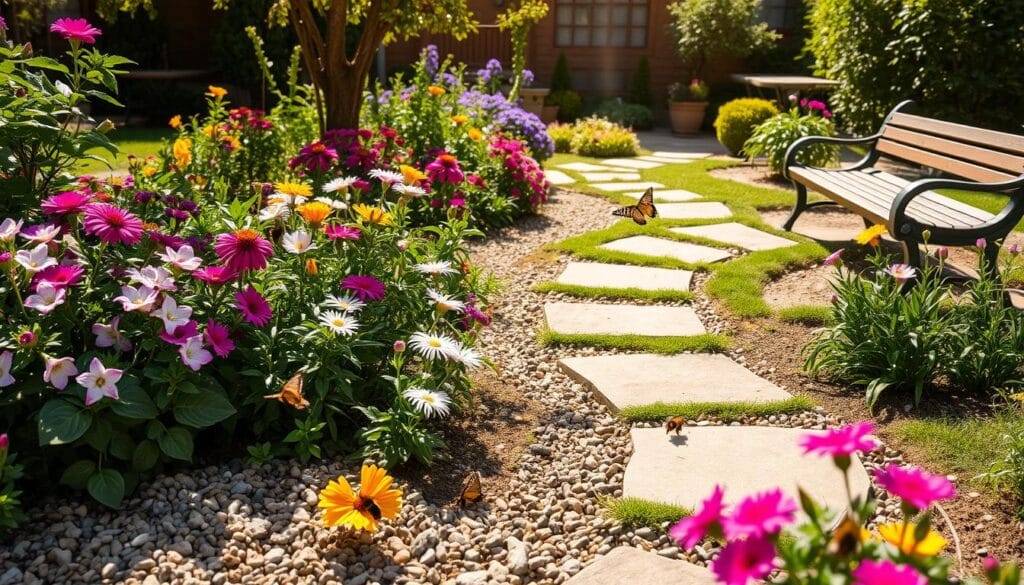
- Using recycled materials for hardscaping features, such as recycled glass or plastic
- Incorporating compost and mulch into your soft scaping to reduce waste and improve soil health
- Creating a pollinator-friendly garden by choosing plants that attract bees and butterflies
By following these tips, you can make a beautiful, sustainable outdoor space. It’s good for you and the planet.
Seasonal Maintenance Tips
Starting DIY landscaping projects means you need to think about keeping your outdoor space looking good. Regular checks for damage or wear are key to keeping your hardscaping and softscaping looking great. This helps prevent about 70% of pest and plant diseases, keeping your garden healthy.
For hardscape upkeep, cleaning and fixing things are important. This includes power washing patios and decks, fixing cracks in walkways, and replacing broken retaining wall stones. Softscape care involves seasonal planting and pruning to keep plants in top shape. This might mean planting native plants, which are easier to care for and less likely to get pests or diseases.
Hardscape Maintenance Tasks
- Cleaning and sealing pavers and stone
- Repairing and replacing damaged hardscape elements
- Inspecting and maintaining outdoor lighting and water features
Following these seasonal maintenance tips will help your outdoor space stay beautiful all year. Choose plants and materials that are easy to care for. If you need help, don’t be afraid to ask a professional. With the right care, your DIY landscaping projects will flourish, creating a lovely outdoor space for years.
Incorporating Accessories and Decor
Adding accessories and decor to your landscaping design ideas can make your outdoor space more inviting. It becomes a place that looks good with your home and nature. Choose garden furniture that fits your space and looks good with your design.
A well-designed landscape can boost your property’s value and make life better. It becomes a special place for you and your family to enjoy for many years. By enhancing curb appeal with landscaping, you create a space that shows off your style. Think about these key things:
- Garden furniture that is durable and easy to care for
- Decor that makes your landscape look better, like planters, statues, and water features
- Lighting that adds to the mood and shows off your landscape’s best parts
Adding these elements makes your outdoor space welcoming and in tune with your home and nature. Pick accessories and decor that show your style and fit your landscape’s design.
Here are some landscaping design ideas for adding accessories and decor:
| Accessory | Description |
|---|---|
| Garden Furniture | Durable and easy-to-care-for furniture that fits your space |
| Decorative Elements | Planters, statues, and water features that make your landscape better |
| Lighting Solutions | String lights, lanterns, and spotlights that add to the mood and highlight features |
By adding these accessories and decor, you can make a beautiful and useful outdoor space. It will show off your style and enhance curb appeal with landscaping.
Common Mistakes to Avoid
When mixing hardscaping and softscaping, knowing common mistakes is key. These mistakes can ruin your landscape’s balance. Follow good garden care tips to steer clear of these issues and make a beautiful outdoor area.
Some common mistakes to avoid include:
- Overdoing hardscaping features, which can make a space feel cold and uninviting
- Neglecting plant health, which can lead to an unbalanced landscape
- Ignoring overall balance can result in a cluttered and chaotic outdoor space
By avoiding these mistakes, you can make a lovely and useful outdoor area. Think about drainage, soil, and where to put plants for a healthy landscape.
Also, think about your landscape’s long-term care. Pick easy-to-care-for plants and materials for your hardscaping. This way, you’ll spend less time and effort keeping your space looking great.
| Mistake | Consequence | Solution |
|---|---|---|
| Overdoing hardscaping features | Cold and uninviting space | Balance hardscaping with softscaping |
| Neglecting plant health | Unbalanced landscape | Regularly water, prune, and fertilize plants |
| Ignoring overall balance | Cluttered and chaotic space | Consider factors such as drainage, soil conditions, and plant placement |
Real-Life Examples of Successful Combinations
Creating your dream garden? Look at how pros and homeowners mix hardscaping and softscaping. A visit to your local botanical garden is a great idea. You’ll see beautiful garden designs in action.
Case Studies of Harmonious Gardens
Walk through your local botanical garden. Notice the stone paths, fountains, and wooden arbors. They blend well with colorful flower beds, green shrubs, and tall trees. These examples can inspire your garden projects.
Inspirations from Landscape Designers
Check out famous landscape designers on social media or design magazines. See how they mix textures, colors, and shapes. Use these ideas to make your garden look great and work well.
Tips on Visiting Local Botanical Gardens
At botanical gardens, watch how hardscaping and softscaping are used. See how pavers, walls, and water features shape the garden. Note the plants and how they change with the seasons. This will help you create a beautiful outdoor space.
Starting your DIY landscaping? Let the designs you see inspire you. With the right mix, your yard can become a peaceful, beautiful retreat.
FAQ
What is the definition of hardscaping in landscaping?
Hardscaping is the non-living parts of a landscape. This includes patios, walkways, and retaining walls.
What is the definition of softscaping in landscaping?
Softscaping is the living parts of a landscape. It includes plants, trees, and lawns. These add color and beauty to outdoor spaces.
Why is it important to combine hardscaping and softscaping in a garden?
Mixing hardscaping and softscaping creates a balanced landscape. Hardscaping gives structure, while softscaping adds life and color. This makes your outdoor space beautiful and functional.
What are the benefits of combining hardscaping and softscaping?
Combining these elements makes your garden more beautiful. It also makes outdoor spaces more useful. Plus, it increases your property’s value.
What are some common hardscaping materials and their uses?
Common materials include concrete, pavers, and natural stone. Each is used for different features like patios and walkways.
How can you maintain hardscaping elements to ensure they remain in good condition?
Keep hardscaping elements clean and repair them when needed. Sealing them also helps. This keeps them looking great and lasting longer.
What are some popular plants and softscaping features to consider for a vibrant garden?
Consider colorful flower beds and lush trees. Ground covers add texture. Choose plants that fit your local climate.
How can you create a cohesive design that balances hardscaping and softscaping?
Plan your design carefully. Place elements thoughtfully. Use focal points to create a harmonious and functional landscape.
What are some essential hardscaping features to consider for an outdoor living space?
Important features include patios and decks for entertaining. Walkways and paths help with navigation. Retaining walls manage soil and create zones.
How can you incorporate sustainable practices in your hardscaping and softscaping design?
Use eco-friendly materials and manage water wisely. Choose plants that attract pollinators. This helps the environment and saves money on maintenance.
What are some common mistakes to avoid when combining hardscaping and softscaping?
Avoid overusing hardscaping and neglecting plants. Also, don’t forget to balance both elements in your design.
Source Links
- How to Integrate Hardscaping into Your Landscape Design, Irvine, CA – https://www.simpleoutdoorliving.com/blog/how-to-integrate-hardscaping-into-your-landscape-design
- Hardscaping vs. Softscaping: How to Balance Your Landscaping to Look Its Best – https://www.newjerseyrealestatenetwork.com/blog/balance-hardscaping-softscaping/
- Balancing Hardscape and Softscape in Your Landscape – https://www.landscapedesigntoronto.ca/balancing-hardscape-and-softscape-in-your-landscape/
- Hardscape vs. Softscape: Understanding the Essentials of Landscaping – https://www.arboristnow.com/news/hardscape-vs-softscape
- What Is Hardscaping? The Basics and Tips for Your Home – https://archipro.co.nz/article/what-is-hardscaping?srsltid=AfmBOoo7RMnOaSnyxgS_LJbE22NRwKWtqs-XQvz5204zTHWNjfCKN2rR
- Landscape Hardscape: Everything You Need To Know – https://www.arkaenergy.com/learn/landscape-hardscape
- Hardscaping vs. Softscaping: Which One Suits Your Needs? – https://www.njlux.com/the-basics-of-hardscaping-and-softscaping-which-one-do-you-need/
- What Is Hardscaping? The Basics and Tips for Your Home – https://archipro.co.nz/article/what-is-hardscaping?srsltid=AfmBOorzl2qhiQ1_As9ShpaSH9WZeZ–zb9NE0_dhyoNU1tk8vSIc-Dr
- Ultimate Homeowner’s Guide to Hardscaping Projects – https://www.groundsource.pro/blog/homeowners-guide-planning-successful-hardscaping-project
- Landscaping 101: A Comprehensive Guide for Beginners – https://www.vevor.com/diy-ideas/landscaping-101/?srsltid=AfmBOorEnCgKF8Diy7Cj5gtiFSNvo_UL5UvZWHRXfQ-wApvRCjWWltQz
- Landscape Design for Beginners – https://www.thespruce.com/landscape-design-for-beginners-2130815
- Master the Basics of Landscaping and Garden Design – https://www.shrubhub.com/blog/master-the-basics-of-landscaping-and-garden-design.php?srsltid=AfmBOopfRv2ZY1Xz9fohPFlX0X2bR1i0eahY6scwOxoK1mDBLhfiI4Dg
- Landscaping 101: A Comprehensive Guide for Beginners – https://www.vevor.com/diy-ideas/landscaping-101/?srsltid=AfmBOorMmNu2UilXJrp0q1_3sNThJ4rbc14PXwu47zHN9lnenwPQx14y
- How to Plan a Softscape Design? – Top Dog Landscaping and Snow Removal – https://topdoglsr.com/resources/softscaping/how-to-plan-a-softscape-design/
- Master the Basics of Landscaping and Garden Design – https://www.shrubhub.com/blog/master-the-basics-of-landscaping-and-garden-design.php?srsltid=AfmBOorrpwv-5Y1EpfFlL6zDBtGJkG8Sf7LH8Tjdpk7juY2kq9GMvP6J
- Hardscaping Essentials for Every Property – State of the Art Landscape – https://www.stateoftheartlandscape.com/landscaping-ideas/hardscaping-essentials-for-every-property/
- Hardscape & Softscape Pros Cons Comparison Guide – ZenFusionHome – https://zenfusionhome.com/hardscape-softscape-pros-cons-comparison-guide/
- How to Blend Hardscaping and Softscaping for a Balanced Landscape – Woodfield Pools & Landscape Design – Maryland – https://woodfieldoutdoors.com/blending-softscaping-and-hardscaping/
- Softscape Landscaping I Carrington Lawn & Landscape – https://www.carringtonlawn.com/softscape-landscaping/
- Dynamism of Hardscape and Softscape in Landscape Design – https://thearchitectsdiary.com/dynamism-of-hardscape-and-softscape-in-landscape-design/
- Sustainable Practices in Landscape Installation – https://vocal.media/serve/sustainable-practices-in-landscape-installation
- Master the Basics of Landscaping and Garden Design – https://www.shrubhub.com/blog/master-the-basics-of-landscaping-and-garden-design.php?srsltid=AfmBOoo9O7KAniKWFy4cOlO2_d-8qF2HyzY3itdAxux8mgy-ECfC827D
- Hardscaping – What is it? – https://seattlelandscapes.com/hardscaping/
- All About Landscaping – https://www.thisoldhouse.com/landscaping/21171537/all-about-landscaping
- Hardscape vs. Softscape Finding the Right Balance for Your Commercial Property – Proscape Landscape & Maintenance – https://proscapela.com/2024/06/11/hardscape-vs-softscape-finding-the-right-balance-for-your-commercial-property/
- A Comprehensive guide to backyard Hardscaping: Tips and Ideas – https://outdoormakeover.net/the-ultimate-guide-to-hardscaping-creating-durable-beauty-in-your-backyard/
- Backyard Design Layouts: 7 Useful Tips – https://www.walpoleoutdoors.com/blog/how-to-design-backyard-layout-7-tips-to-ease-your-process?srsltid=AfmBOor6zYbyhJIHzCqDv8TP4PK9AVWsDu2uloYhMwFy-wJodxcP4Gy9
- Outdoor Hardscape Ideas – https://apexlandscaping.com/outdoor-hardscape-ideas/
- Hardscape and Softscape: What’s Best for Your Yard? – https://www.elmlandscaping.com/hardscape-vs-softscape-whats-best-for-your-yard/
- 15 Common Landscape Design Mistakes – Avanti Landscaping – https://avantilandscaping.ca/landscape-design-mistakes/
- Landscaping for Beginners: Tips and Ideas – No Limit – https://nolimitlandscapes.com/landscaping-for-beginners-tips-and-ideas/
- What is Hardscaping – Green Gold Landscaping Inc – https://www.greengoldlandscapinginc.com/what-is-hardscaping/
- The Best Shrubs and Trees for Natural Privacy Fence Plants




